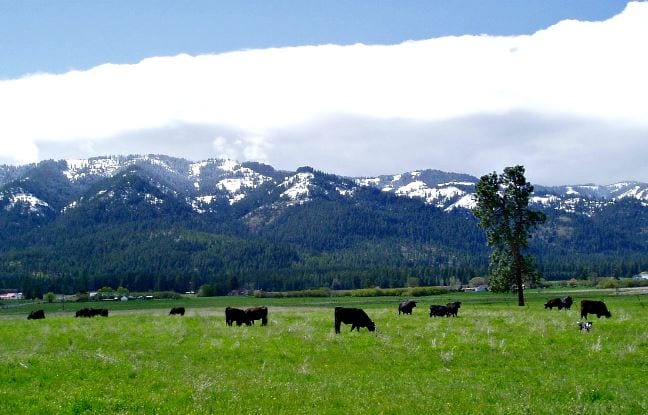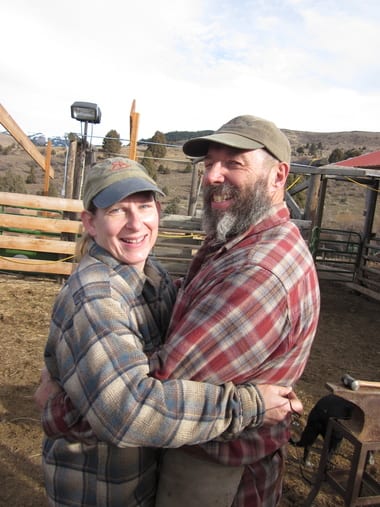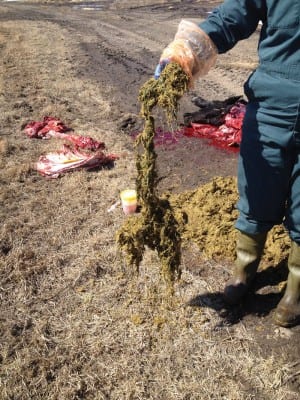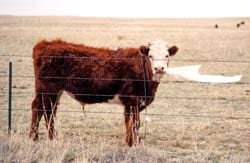 Cattle at Paradise Ranch Cattle at Paradise Ranch Help ranchers raise $40,000 to save animals by 4pm Pacific 6/11/15Answers to Inquiries Cows Eating Plastic & Baling Twine |
The latest from Paradise Ranch: The judge has ordered that all the animals we are charged with neglecting be forfeited unless we pay a bond of $39,780 by 4 p.m. Pacific time, Thursday, June 11. Unless we come up with the money by that time, 35 of our animals (cows and their calves, yearlings, and a boar) will be forfeited.
My partner, Ross, and I are small ranchers in eastern Oregon. We produce grass-fed beef and lamb. We’re passionate about our work and life. But now we stand accused as criminals, facing animal neglect accusations. We are being charged with 45 counts of neglect. If convicted, these charges could result in a significant jail sentence. We are being targeted by a joint effort between the Union County District Attorney’s Office and essentially an animal rights foundation because of how we manage our livestock which we raise to provide meat for our customers.
What we do is considered immoral and criminal by the California-based Animal Legal Defense Fund and we are being prosecuted by the only special prosecutor in the country whose salary is paid by a private special interest group. Jacob Kamins is the State of Oregon “Animal Cruelty DDA.” His position is funded by an annual grant from the Animal Legal Defense Fund. His home office is the Benton County, Oregon District Attorney’s office, but he appears in cases all over the state, including our case in Union County.
How Our Grass-Fed Meat Business Got Started
Ross and I started living our dream in 2009. After we met, I moved from Washington to Oregon to live at his ranch in a tiny place called Medical Springs. I purchased a ranch property in Summerville, Oregon for pasture. I was leaving a stressful job and suburban living for a country life working outdoors. I was also sick. I had spent two years battling Crohn’s disease including a hospitalization and was still recovering from the aftermath of brain surgery to remove a brain tumor. I was on a journey back to good health having decided to give up processed food and eat real food, including grass-fed meats. I was at a healthy weight for the first time in my adult life and I was making great progress keeping the Crohn’s disease in remission. I wanted to share my success as part of my dream.
 Ava and Ross, owners of Paradise Ranch Ava and Ross, owners of Paradise Ranch |
Ross and I decided to start a grass-fed beef business. We were passionate about sharing our meat with others who were also looking for healthy food and healthy bodies. Over the next years, our passion increased as our business increased and our customers shared their personal stories about good eating. Today, we produce grass-fed beef and lamb and milk-fed pork. We’re proud that every cut of meat we sell comes from an animal that we raised from birth, so we can tell our customers with confidence about that animal’s life and care. We only sell directly to consumers because we want the people who eat our meat to know us personally. So, we’ve adopted the USDA’s motto: “Know your farmer. Know your food.” We don’t ship. We only deliver so that each customer gets a handshake or a hug and we can swap stories. Ranching is a tough life full of challenges, accomplishments, and heartbreak. But we love it. We’re living our dream every day. And our customers love what we do.
Law Enforcement + Ignorance = Disaster
On Tuesday, January 27, 2015 we became accused criminals. The Union County Sheriff’s Department served us with a search and seizure warrant after several animals died over an extended period of time. The next day, they confiscated every head of livestock from our Summerville, Oregon property on the grounds of “criminal neglect”—but nothing more specific than that. They stole our breeding boar and sow, 6 mules, 5 horses, 23 yearling calves, 2 bulls, 4 steers, and 43 cows. The mother cows represent years of genetic selection for cows that will do well living on pasture and eating only grass. Almost all of our mother cows, all of our future beef, and hog breeding stock were taken. This is the majority of our livestock. Prior to the seizure, law enforcement had not presented us with any specific concerns that they wanted to see addressed. They did not work with us to have a veterinarian come on the property to assess our animals. They did not ask to see our hay purchase records to confirm how much hay we were buying and feeding. They had never cited us for lack of appropriate care for our livestock. This led us to think we were meeting their expectations. But in a matter of hours, they took our past, present, and future.
As shocked and surprised as we were at this event, it did not come out of the blue. It was a long time in the making. It started in 2013 when we got complaints from the Union County Sheriff’s Department. An animal control deputy was driving by the property 2-3 times a day. She thought the horses were on pasture that was too short. She thought the cows didn’t have enough to eat. She didn’t see any feed out for animals. She acknowledged that all the animals looked healthy, but she was worried that they might “run out of food in a month.” She complained that no one lived on the property and expressed concern that we weren’t on site often enough. Then we started getting reports that the neighbors were complaining—about the same things. By November 2013, the amount of contact from the Sheriff’s Department reached harassment level. We made an appointment with the deputy sheriff and our veterinarian to meet at the property and be present while the veterinarian assessed all our livestock. The complaining deputy sheriff and her supervising officer were both supposed to be present for the assessment. They cancelled. Our veterinarian assessed every horse, mule, hog, sheep, cow, and steer. They were all in good health and satisfactory body condition. Our veterinarian wrote a report and sent it to the deputy sheriff. The deputy sheriff told us that the matter would be closed and she would communicate the content of the vet’s report to our neighbors who were complaining to keep them at bay.
We thought we were finally going to have peace. We had demonstrated to concerned sheriff’s deputies that we were, in fact, responsible livestock owners. We visited the property regularly. We took care of the animals. We fed when necessary under the terms of our management program. In fall of 2014, it all started again. We were told that neighbors were complaining about the horses and mules being neglected. We continually asked if there was a single thin animal. The response was always, “No.” Then on December 5, 2015, we received a message that our flock of sheep had “NO food”. The deputy demanded that we get to the property immediately and feed the sheep despite the fact that two cattle feeders full of quality alfalfa hay were on a side of the barn not visible from the road. We reminded the deputy that we are in the meat business and it made no sense for us to starve the very animals that are our livelihood. The deputy seemed to accept our response.
Then, on December 26, 2015, we got an e-mail message from the deputy that a neighbor was, again, complaining about the horses and sheep being neglected. We agreed to meet her and a sergeant at the property. At that time, we were feeding hay to sheep, horses, and mules, and had been for some time. We showed them the horses. They agreed that they were healthy and even their feet looked fine. We showed them the sheep and their feeders full of hay. They agreed that the sheep were being cared for. We walked among our herd of cows and yearling calves. We all acknowledged that some of the cows were on the thin side; but it was winter, the cattle were out on pasture, and we explained that we expected them to gain weight when we started feeding hay. We explained that we would start feeding cattle within days. No citation was issued.
The following weeks were full of soggy, wet, winter weather—the toughest type for livestock and livestock owners. The entire 160-acre property was waterlogged and flooded in some places. Cows and yearlings were getting stuck in mud. No animal was dry. Most of the property was inaccessible to our tractor due to the mud. Several cows had died over a period of time (we now have evidence that they had consumed plastic bags and baling twine that had blocked their guts). But we made sure that all the animals had a constant supply of hay in their feeders. It wasn’t enough for the Union County Sheriff’s Office. All our animals were seized.
Mother Nature is Brutal
It’s easy for law enforcement employees, casual observers, or neighbors to be judgmental and self-righteous when observing the activities on a ranch. It’s easy to second guess another person’s management decisions. Ranching is full of controversy for some people. It’s common industry practice for animals to be castrated without anesthetic, cows get dehorned, injured or sick animals are usually euthanized at the end of a gun barrel, etc. But the worst for ranchers is Mother Nature. She is not kind, sympathetic, or compassionate. She’s brutal. We struggle to keep our animals safe from predators and disease, to move animals to the best places for different seasons of the year, to keep mothers close by when they are calving, lambing, and farrowing, to keep animals fed appropriately, and to provide veterinary care when we know it will make a difference. We struggle with the knowledge that any mistake, accident, or poor decision in dire circumstances can cost a life. We also struggle with financial reality. We’re not doing this to get rich, but we do have to make a living in order to pay our bills and stay in business serving our customers.
Is Justice Blind?
We now find ourselves battling something far more intimidating and frightening than even Mother Nature. We’re battling our justice system. Lady Justice is supposed to be objective and impartial, and she is often represented wearing a blindfold. But justice does not seem blind when you’re being prosecuted by someone whose salary is paid by a special interest group. Especially when you’re a rancher and the special interest group is an animal rights organization. Is this “prosecution” or “persecution?” The Animal Legal Defense Fund would like to see all animals have the same rights as human beings. They would like a society where animals are not consumed as meat or kept as livestock. If you want to know more about their agenda and their goals, you can read about them yourself on their website. One book they’re promoting is The Modern Savage: Our Unthinking Decision to Eat Animals by James McWilliams. The ALDF staff writer blogging about this title makes the claim that, “the reality is cruelty to animals exists on smaller, so-called ‘humane’ farms as well as on industrial-scale ‘factory farms.’” Simply put, their belief is that we’re cruel because we’re ranchers.
This organization has decided to change the things they don’t like in society by “expanding” the law. Their goal is to litigate and set as much precedent as possible to give animals the same rights as humans. To serve this goal, they have developed an Animal Law program that is now taught in many colleges and universities across the United States, including Lewis and Clark Law School in Portland, Oregon where Jacob Kamins attended school.
Our small livestock business is the target of their (the Animal Legal Defense Fund) precedent-setting efforts. We believe we are a test case. Specifically, we believe they are using the cattle industry’s body condition scoring tool to set a precedent that defines a neglected cow as a cow rated as 3 on this scale of 1 – 9. This is not a law enforcement or legislative tool. A 3 rated cow is considered thin but within the normal range for beef cattle. It’s a management tool for cattle producers. The vet the county had inspect our cattle after the seizure did not score any of them below 3. It’s shocking to think what it will mean to ranchers and livestock producers all over the country if we are successfully prosecuted for making decisions and treating animals within the boundaries of industry standards. If law enforcement prosecutes every rancher who loses animals, has thin animals among their herd, doesn’t feed them as much as someone else thinks they should be fed, has animals outdoors in bad weather, or does not call a veterinarian every time there may be a problem, then there will be no one left to raise pastured, grass-fed meat free from drugs and antibiotics.
Your Food is Going Underground
Despite the fact that our ranch is in a district zoned for agriculture and is located in an agricultural area, we realize that we will probably not be able to continue to ranch here. We are clearly not welcome. Neighbors and law enforcement do not have the experience or knowledge to understand what we do. Our business is conducted out in the open, so anyone who passes by can misunderstand and pass judgement. The consequence is that your food supply system will continue to be driven underground. More and more of it will occur in remote and isolated locations where the public cannot gain access to see what happens to these animals. More and more of it will occur in industrial-type buildings where so many hogs and chickens are already raised out of sight in disturbing and thoroughly inhumane environments. And you will have less and less access to real food produced by farmers and ranchers in your immediate locale. You will have less and less ability to buy real food directly from a farmer.
Please Help
Our legal fees are growing well beyond our ability to pay them. Our attorneys have expressed confidence that we have committed no crime. We are hopeful that we will prevail in the event of a trial. For now we are facing major losses. The judge, hearing our case, has ordered that all the animals we are charged with neglecting will be forfeited by 4 p.m. Pacific Time, Thursday, June 11 unless we pay a bond of $39,780. (The Special “Persecutor” sought to force us to forfeit every single animal that was seized and their offspring despite the fact that we were accused of insufficiently feeding a fraction of the animals that they seized from us.) Our attorneys have told us that they will be appealing this decision but to expect to pay a bond if we want to keep our animals. If we do not post the bond, the animals will be sold and all proceeds of the sale will go to Union County giving them a financial windfall of as much as $25,000-$30,000 beyond their costs of caring for the animals since the seizure.
If we lose our business, it’s the Animal Legal Defense Fund that wins. To win the legal battle and lose everything in the process is a loss for us, our community, our customers, and the ranching industry overall. Please help us to keep this from happening. Your donation will help pay our legal costs and the costs associated with getting our seized animals returned. Your donation will keep us in business while we resolve this criminal case, so we can move forward into a future where everyone can “Know your farmer. Know your food.”
See our Pledgie campaign here.
Thank you,
Ross Painter and Ava Denton, ranchers
Ava and Ross are FTCLDF members, but FTCLDF attorneys are not representing them since they had already retained local attorneys by the time they contacted the office.
ANSWERS TO INQUIRIES
Rancher Ava Denton offers honest and direct answers to inquiries about ranch conditions, realizing that no explanation will be enough for some people.
Cows Eating Plastic and Baling Twine
 Photo: Read Canadian Cattlemen article,”Can twine kill a cow?“Cattle can die from eating twine or net wrap left on big bales or put through the bale processor. And Dr. John Campbell, head at the Western College of Veterinary Medicine, in Saskatoon thinks it happens more often than we think. [Read more] |
In regards to eating plastic and baling twine. Cows do NOT eat plastic because they’re hungry and twine is not “wire”. All of the baling twine that is on bales we feed is removed and placed in an inaccessible area until spring. It is then recycled or burned. When I bought this property in 2008, we discovered that the previous owner had fed hay WITHOUT removing the baling twine. In every place where he had fed cows for 40 years there was baling twine buried deep in the ground. Frost heave during the winter pushes it up. As we see it, we remove it.
What caused a problem this winter was that the ground on our 160-acre property never froze, like it has every winter in the past. On top of that, unusually heavy rains in early January caused the property to flood. It is in the very bottom of a valley with 3 creeks that run through it. We cut open fences to move the cattle into the driest area on the property while we were moving animals to our home property one load at a time. Unfortunately, this was an area with a lot of buried baling twine. Cows are like vacuums. They are not discriminate eaters and will simply pick up and swallow anything in their path. So, a few were eating baling twine that we didn’t know about.
 Photo: International Texas Longhorn Association article, “Mysterious Cattle Deaths?“This yearling removed a piece of construction plastic from a barb wire fence. I tried to retrieve it but he was too “smart” and I could never get close enough to grab it. He stood about 20 feet away and ate the whole thing. He was in a pasture with several hundred steers his own age. The owner probably lost him and never had a clue why.[Read article] |
After we opened rumens on dead cows, we realized that they were also eating plastic bags. These bags are being blown onto the property from surrounding high-traffic areas. At the time, no one was living on the property generating any garbage. Also, at least one bag in a cow gut was the bag that covers a package of baling twine. This bag was actually baled inside a bale of hay and was not visible when we fed the bale to our cows. It is possible that more of the plastic was actually inside bales of hay. While the ground was soggy and soft, we removed several pick-up truck loads of baling twine by pulling it out of the ground with a tractor. I’m sure that’s not all of it, so we will have to continue to do this. According to our research, cows can eat plastic because they’re hungry, but they also eat it, especially when they are on dry feed (like fall pasture or hay) because they are attracted to the phosphorous that it contains. We always provide a mineral salt for our cattle, but it’s possible they were eating it for this reason.
Even when you have several animals die, it can take some time to figure out the cause. In our case, it took longer because two vets performing two necropsies did NOT open rumens and look for plastic. We discovered this on our own.
As soon as we discovered that plastic was a problem, we took action:
We have already begun moving fences on the property. In the future our cows will not graze on pasture where we know there is buried plastic. Sheep and horses can graze this pasture because they are very discriminating eaters and don’t eat plastic garbage.
We removed buried baling twine from any area where we knew it to be buried.
We will locate another hay provider in a less populated area to reduce the possibility of plastic being baled inside the hay bales.
Thick & Thin: How Cows Look
In regards to having thin cattle in a herd. Cows are like people. In any group of people, there are fat ones and thin ones and ones in the middle. For cows, their weight changes throughout the year as they breed, calve, wean, and then breed again. So, fluctuations in cow weights are common and expected throughout the year. All of our cows were at normal weights for a period when they are receiving dry food (hay). Cows gain weight once they are put on spring pasture and eating green grass. They eat more of it and it has a higher nutritional value.
Tough Winter: Wet & Soggy Ground
In regards to dealing with a wet and soggy property. I can’t make creeks stop running or stop rain from falling. I can’t stop lightning from hitting the property. The very water that grows so much fine pasture on my property can also become deadly. When the creeks are at flood stage, animals can drown when trying to cross them or get stuck in the mud in the aftermath. These are not common events, but they happen. As mentioned above, this winter was unexpectedly bad.
“Humane” vs. “Inhumane”
The definition of “humane” is very personal. Some people think that it’s inhumane to eat animals. For those people, we’re committing a crime because we eat meat. Some people think that all animals should have shelter just like people do and if they don’t, that’s inhumane. Because our horses and cows live outside year-round just like wild horses and wild ungulates, we’re committing a crime. These are the people who keep pigs as indoor pets and put pajamas on their goats (I’m not kidding. I just saw an advertisement for someone who makes these clothes.) The truth is that any environment has risks. Along with “humane”, people also define “natural” differently. We define that as raising animals in an outdoor environment as much as possible. But that means our animals are exposed to weather, predators, and other natural and man-made hazards that we can’t always predict or prevent.
For every neighbor who complained (2), we have 3 who are familiar with our property and practices and are happy with what they see. One of these complaining neighbors is a vicious racist who has called me and my daughter some pretty horrible names because I was married to a Chinese man who is the father of my daughter. She’s a “half-breed.” Every neighborhood has at least one resident jerk. On top of that, people today are very judgmental. Social Media helps promote this – people like to tell others how to raise their children, discipline their children, what to eat, what religion to practice, and what politics to adhere to among many other things. Everyone thinks they know best. 😉 But there’s the old saying that goes something like, “Don’t judge someone until you walk a mile in their shoes.”
The reality is that livestock producers can care very much about their animals and work very hard to provide the best environment for them and still not be “humane” as some people define it. Because that environment is not going to be the same as the environment that I provide for my human daughter. The Merriam-Webster definition of “humane” is – kind or gentle to people or animals. It doesn’t mean to treat animals like we would treat people or with all the same considerations.
Industry standards for ranchers include: raising cattle and horses outside with no shelter, euthanizing sick or injured animals by gunshot, castrating male animals (without anesthetic), dehorning cattle, branding with a hot or cold iron, ear-tagging, ear-notching, dew-lapping, grazing animals on Forest Service or Bureau of Land Management property, providing their own veterinary care and treatment, artificial insemination, disposing of dead animals by placing them in an isolated area to decompose, and on and on.
Industry standards for ranchers do not include: using the most modern and expensive diagnostic techniques like MRIs when an animal is sick or injured, treating animals at all cost (like giving an injured cow a hip replacement or providing a prosthetic limb), calling a vet to treat every illness or injury, providing blankets and rain sheets for animals to wear in bad weather, providing climate-controlled housing, feeding animals until they are unnecessarily fat, and on and on.
So, I’m sure that we do a lot of things that some people are going to find offensive, even if we don’t do all the things that are considered “industry standards” because WE don’t like some of them. The point is that if we arrest and convict local ranchers for following accepted industry practices, THERE WILL BE NO MORE MEAT OUTSIDE THE INDUSTRIAL PRODUCTION MODEL. People won’t complain about what they can’t see. So, the big producers will continue to raise animals inside buildings and on feedlots – far from the public eye. And I think most of us would consider those environments “inhumane”.
YOUR FUND AT WORK
 Services provided by the Farm-to-Consumer Legal Defense Fund (FTCLDF) go beyond providing legal representation for members in court cases.
Services provided by the Farm-to-Consumer Legal Defense Fund (FTCLDF) go beyond providing legal representation for members in court cases.
Educational and Political Action Services also provide an avenue for FTCLDF to build grassroots activism to create the most favorable regulatory climate possible. In addition to advising on bill language, FTCLDF supports favorable legislation via action alerts, social media outreach, and the online petition service.
You can help FTCLDF by becoming a member or donating today.

 Anyone wanting to make a contribution to support the work of the Fund can make a donation online or send a check to:
Anyone wanting to make a contribution to support the work of the Fund can make a donation online or send a check to:
FTCLDF
8116 Arlington Blvd, # 263
Falls Church, VA 22042
Prefer to make a tax-deductible donation? Contact us by email at [email protected] or call 703-208-FARM (3276).